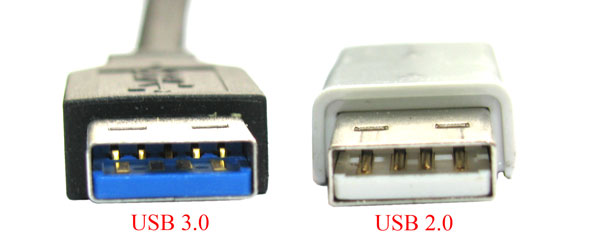USB 2.0 vs 3.0
USB 3.0 was a big leap from USB 2.x standard. 3.0 improved data transfer speeds at 5 Gbit/s which is up to 10 times more than the initial 2.0 standard. For easy identification, 3.0 oftens comes blue-color coded port while 2.0 comes in black. Almost all latest computers, external hard drives, routers, smart tvs now come with one or more USB 3.0 ports with the rest being 2.0. The great thing about USB 3.0 is that it maintains backward compatibility with 2.0 devices. This means you can easily plug in a 2.0 device in a USB 3.0 port and it still works. USB 3.0 came with better power management techniques on top of faster data transfer speeds. The new standard is able to deliver 900 mA, increasing total power delivery from 2.5 W to 4.5 W (at 5 V). USB 3.0 also introduced battery Charging 1.2 specification delivering power of up to 7.5 W to 3.0 devices. That meant more devices could be USB-powered instead of being juiced up from the power socket. When it comes to cables, USB 2.0 supported maximum cable length is 5 meters while USB 3.0 handles only 3 meters.
USB 3.0 vs 3.1 vs 3.2
But USB 3.0 since it’s release on November 2008 has made updates. USB 3.1 also known as USB 3.1 Gen 2 came in January 2013 doubled the data transfer speeds to 10 Gbits/s. In July 2017 USB standard group promoter announced USB 3.2 which increased data transfer speeds to 20 Gbit/s over USB type C interface. The increased speeds were as a result of multi-lane operation or combining two 10 Gbits/s lanes. Related post: USB 3.2 is out with transfer speeds of up to 20Gbps, twice as fast as its predecessor Updates: There’s been a lot of confusion on the 3.x spec because of a lot renaming of old standards. For instance USB 3.0 with 5Gbits/s got renamed to USB 3.1 Gen 1 and then renamed again to USB 3.2 Gen 1. Similarly 10Gbits/s USB 3.1 Gen 2, got renamed to USB 3.2 Gen 2.
USB 4.0
USB 4.0 was released on 29, Aug 2019 by the USB Implementers Forum. Unlike the other earlier standards, it’s the only USB protocol that requires USB Type C connector. It handles data transfer speeds of up to 100 Gb/s. That’s about 5 times faster than USB 3.2. Right now, even the fastest hard drives are not even able to max out USB 3.X speeds. Even super fast SSDs read/write speeds max at roughly 6 Gbps like the Samsung 850 Pro or SanDisk Extreme Pro. So there’s really no point of increasing USB speeds until hard drives become faster. Key features of the USB4 solution include:
Two-lane operation using existing USB Type-C cables and up to 40 Gbps operation over 40 Gbps certified cables. Multiple data and display protocols to efficiently share the maximum aggregate bandwidth over the bus. Allows tunneling of DisplayPort and PCI Express.USB4 requires USB Power Delivery (USB PD) which can deliver power up to 100W. Backward compatibility with USB 3.2, USB 2.0 and Thunderbolt 3
The first major laptops to support USB 4.0 were Apple’s Mac Mini (M1, 2020) (2 controllers), MacBook Air (M1, 2020), and MacBook Pro (13-inch, M1, 2020). More PCs are expected to support the standard through Intel’s Tiger Lake processor.
USB vs. Thunderbolt
Even though USB tries to get faster, it’s still no match to thunderbolt. USB 3.1 Gen 2 pushed the speeds to 10 Gbits/s but that’s exactly what Thunderbolt 2 was capable of. Thunderbolt’s latest standard 3.0 is cable of a whooping 40 Gbits/s, twice as fast as as USB 3.2 — the latest USB standard. But here’s the thing; Thunderbolt isn’t yet as popular as USB unless you use a Mac. MacBook Pro (2016 and later) and iMac (2017) support Thunderbolt 3.0 with USB type C connector. Now it can be confusing at first when you mention Thunderbolt 3.0 and USB type C in the same sentence. But if you understand computer connectors and cables, it shouldn’t be. USB Type C is simply a connector or a port which basically is a physical computer interface that provides input/output operations for computer peripherals like flash disk, external hard drive, smartphone, camcorder, projector etc. USB-C combines data transfer, video output, and charging capabilities in a single, compact connector. Connectors need actual compatible cables that plug connect devices together. So for a USB type C interface which allows you to plug in both ways, you also need a corresponding USB Type C cable. Related post: Thunderbolt 3 vs USB Type-C: The spot-on difference USB and Thunderbolt on the other hand are simply computer data transfer protocols or standards. These define specifications; speeds, power, pins etc for communication and data transfer between electronic devices. Therefore it’s possible to have USB and Thunderbolt standards support a USB Type C port. Which means you can plug in a USB device to a Thunderbolt port. In the future, we might see a convergence of USB and Thunderbolt where one standard and one port will rule them all. That’s most likely going to be Thunderbolt with USB Type C.



